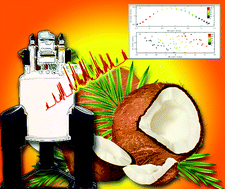Detection of the adulteration of fresh coconut water via NMR spectroscopy and chemometrics†
Abstract
Here, we applied NMR spectroscopy in combination with chemometrics to quantify the adulteration of fresh coconut water, stretched with water–sugar mixtures. Coconut water was extracted from young Costa Rican coconuts and adulterated with concentrations of various sugar solutions. A total of 45 samples were analysed by 1D proton NMR spectroscopy and chemometrics. Results showed highly sensitive quantification, with a limit of detection of adulteration with sugars of 1.3% and a root-mean-squared error of prediction of 0.58%. Interestingly, we identified a regular drift in the chemical shift and a change in the lineshape of malic acid signals concomitant with increasing levels of adulteration. On further investigation, this was found to originate from changes in the concentration of divalent cations, such as magnesium, within the samples. It can be concluded that 1H NMR spectroscopy enables accurate quantification for the degree of adulteration in this product, with the added discovery finding that the shift and lineshape of the malic acid signal can be utilised as a potential diagnostic marker for partial substitution of fresh coconut water with extrinsic components such as sugar mixtures.



 Please wait while we load your content...
Please wait while we load your content...